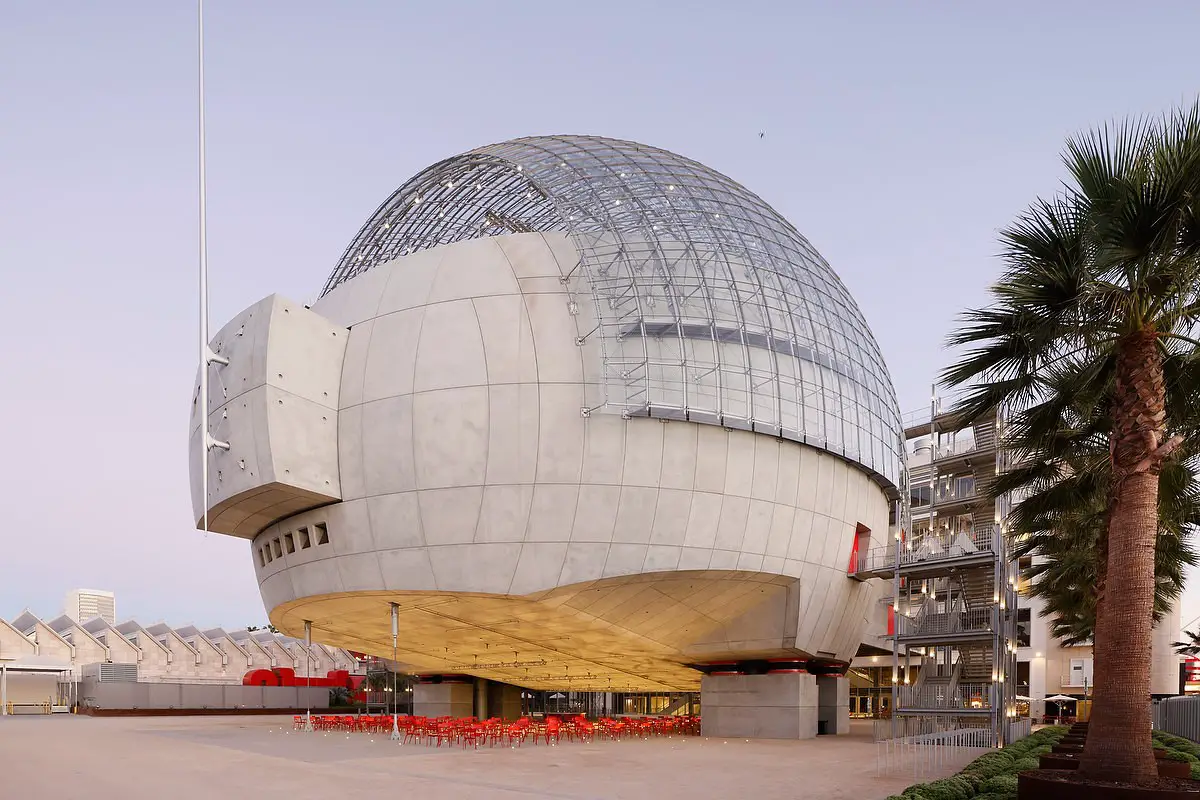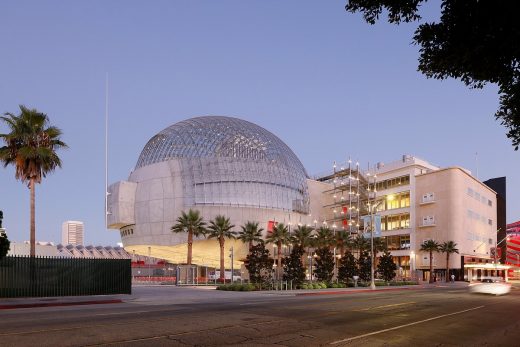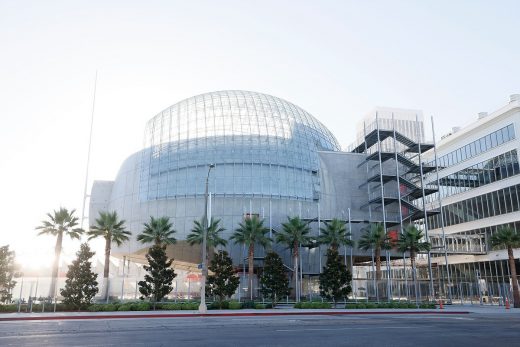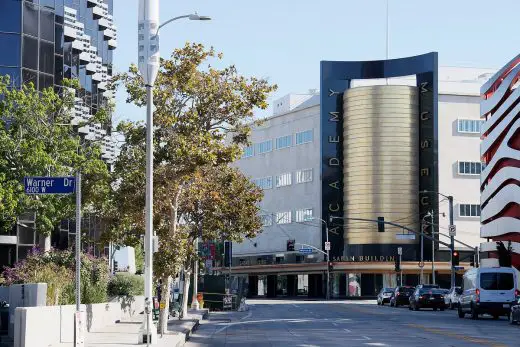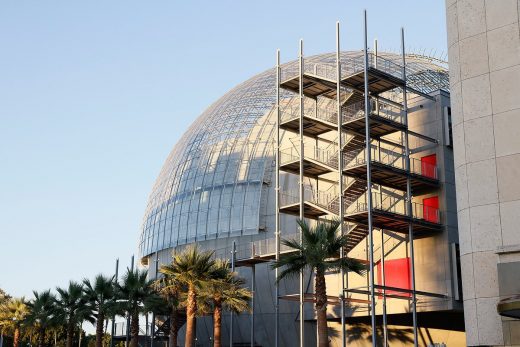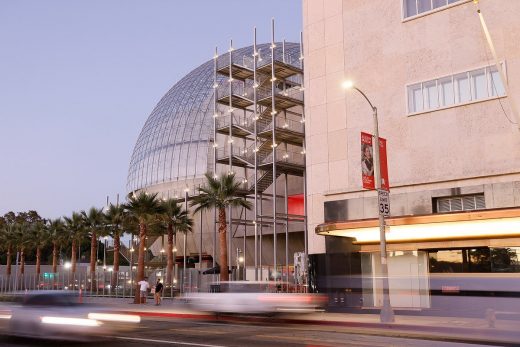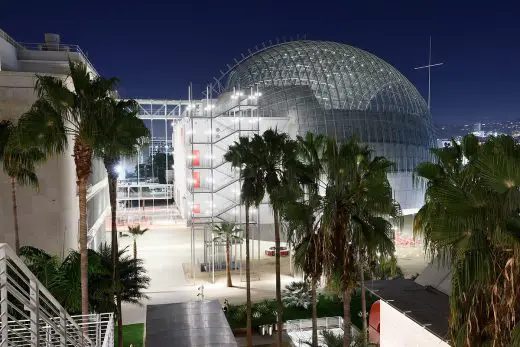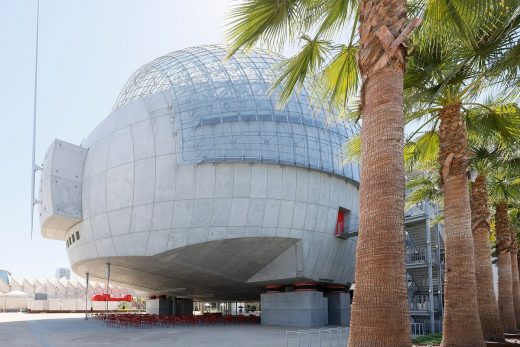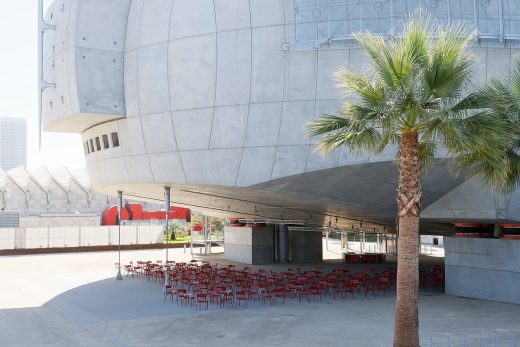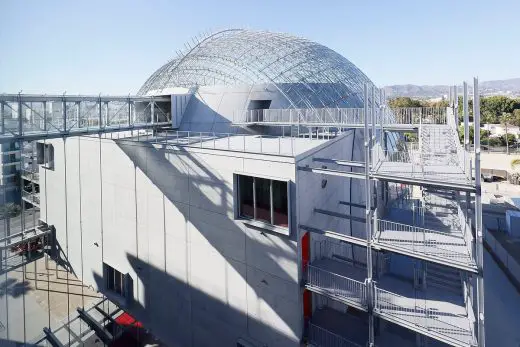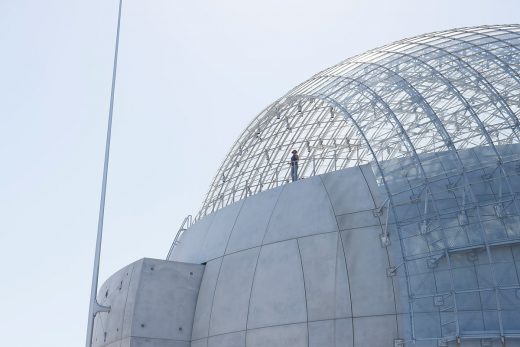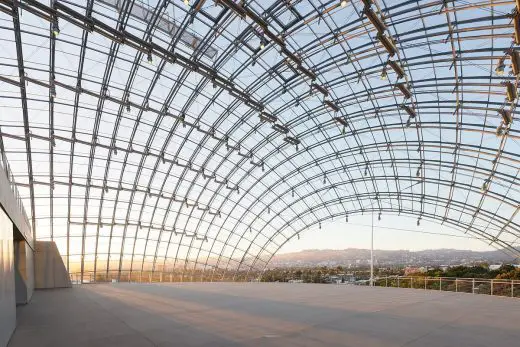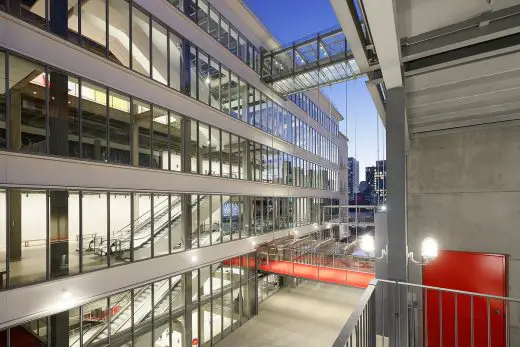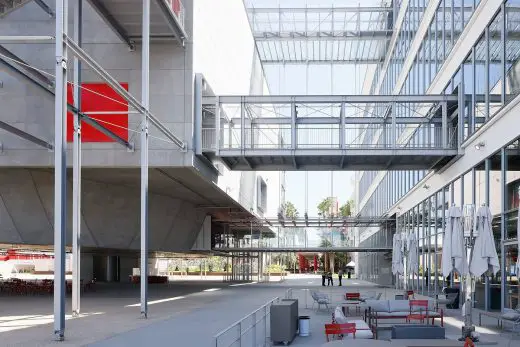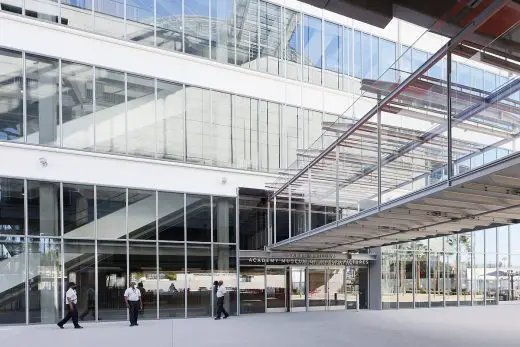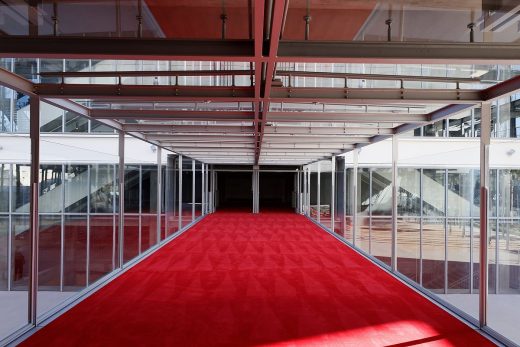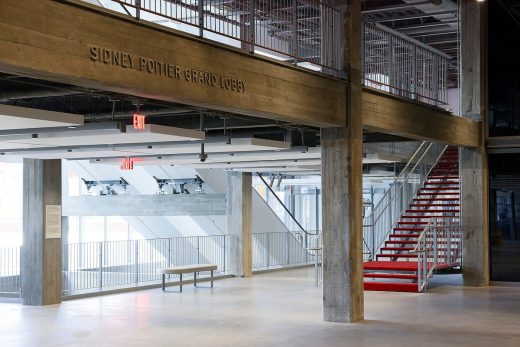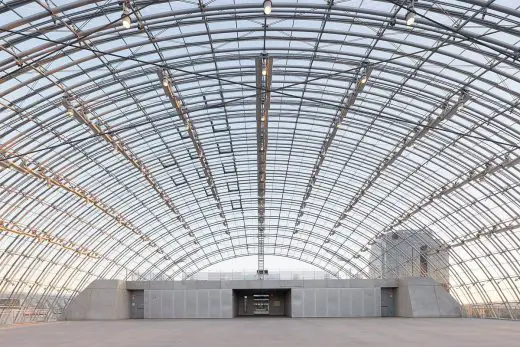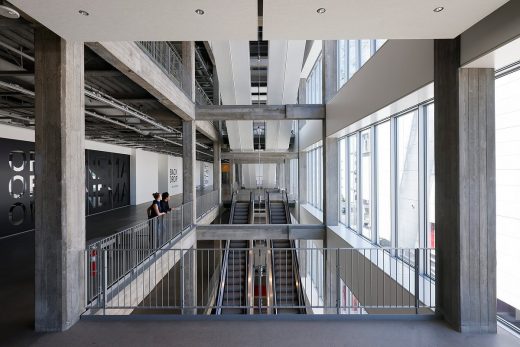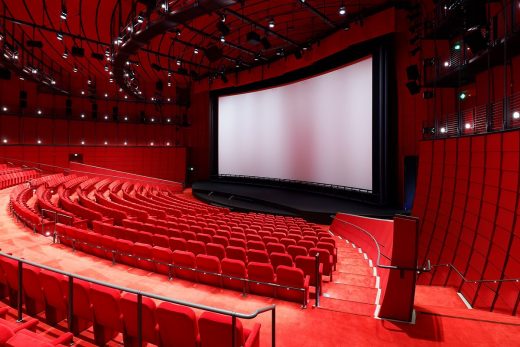Academy Museum of Motion Pictures Los Angeles Building, Californian Architecture Photos
Academy Museum of Motion Pictures in Los Angeles
Sep 22 2021
Location: Wilshire Boulevard – Miracle Mile, Los Angeles, California, USA
Academy Museum of Motion Pictures, Los Angeles
Opening September 30, 2021
Architect: Renzo Piano Building Workshop (RPBW)
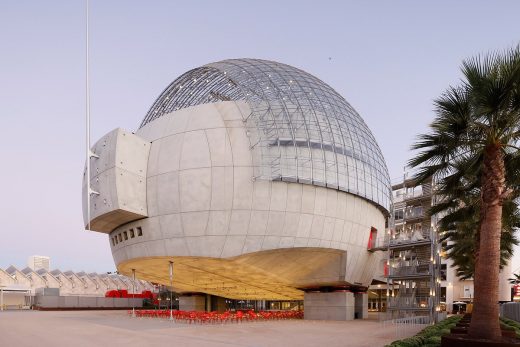
photos : Iwan Baan ©️ Iwan Baan Studios
Academy Museum of Motion Pictures Building News
ACADEMY MUSEUM OF MOTION PICTURES
OPENS TO THE PUBLIC ON SEPTEMBER 30
Design by Italian architect Renzo Piano
Wednesday 22 September 2021 – Inviting the world into an unparalleled experience of the arts, sciences, artists, and social impact of moviemaking, the Academy Museum of Motion Pictures will open its doors to the public on Thursday, September 30, 2021, following a dedication ceremony attended by civic, cultural, and entertainment leaders and officers of the museum and the Academy of Motion Picture Arts and Sciences. Located in Los Angeles, the world capital of moviemaking, the new museum is the largest in North America devoted to exploring films and film culture and is the only such museum in Los Angeles.
Bill Kramer, Director and President of the Academy Museum, said, “We are living in changing and ever-evolving times, and now more than ever we need to come together to share our stories, learn from one another, and bond over being entertained and delighted. This is what movies do, and we are thrilled to be opening such a dynamic, diverse and welcoming institution devoted to this beloved artform. I am so deeply grateful to the entire Academy Museum team and all of our partners who have worked with such dedication and integrity in building this new institution—for Los Angeles and for the world.”
Jacqueline Stewart, Chief Artistic and Programming Officer of the Academy Museum, said, “We eagerly await engaging visitors in accessible, multifaceted conversations about the history of filmmaking and the impact that cinema has on our lives. We look forward to welcoming people to the museum, our galleries, theaters, and educational spaces. We hope visitors will learn more about films they know and love, make new cinematic discoveries, and feel inspired to share their own stories.”
Ted Sarandos, Board Chair of the Academy Museum and Co-CEO of Netflix, said, “The Academy Museum reflects the broad community that creates the collaborative art of the movies, and the museum has been built by that community. On behalf of the board, I thank the Academy’s Board of Governors, campaign chair Bob Iger and co-chairs Annette Bening and Tom Hanks, and the generous individuals, corporations, foundations, and government entities—more than 13,000 in all—whose gifts have made the Academy Museum possible. My special thanks go to the leadership and staff of the Academy Museum, Renzo Piano Building Workshop in collaboration with Gensler, and exhibition designer WHY architecture, whose brilliant work has given us the movie museum we have dreamed of for so long.”
Dawn Hudson, CEO of the Academy of Motion Picture Arts and Sciences, said, “The dream of building a museum dedicated to movies has been 90 years in the making for the Academy. No matter what’s been happening in the world since then, no matter what the challenges, that dream has lived on. Now people from all over the galaxy will enjoy the incredible talents of our members and of all the artists who make movies. This is now a reality that would not have been possible without the dedication and focus of hundreds of incredibly talented people and their will to see it come to life. It is with immense pride that we celebrate the opening of the Academy Museum of Motion Pictures.”
David Rubin, President of the Academy, said, “Since 1929, when the first Academy board and its president Douglas Fairbanks dreamt of a museum devoted to motion pictures, our governors through the decades have sought to realize that dream. The Academy’s branches and governors are grateful to Bill Kramer and the museum staff for their creativity and collaborative spirit, and we salute our Academy CEO Dawn Hudson for her perseverance in reaching this milestone event.”
The seven-story, 300,000-square-foot museum, which draws on the unique resources of the Academy of Motion Picture Arts and Sciences and is located in the heart of LA’s Miracle Mile, will open with:
- the 30,000-square-foot core exhibition Stories of Cinema, offering celebratory, critical, and personal perspectives on the disciplines and impact of moviemaking, past and present
- the temporary exhibition Hayao Miyazaki, the first museum retrospective in North America of the work of the acclaimed filmmaker and Studio Ghibli
- The Path to Cinema: Highlights from the Richard Balzer Collection, with selections from the world’s foremost holdings of pre-cinematic optical toys and devices
- Backdrop: An Invisible Art, a double-height installation that presents the painting of Mount Rushmore used in North by Northwest (USA, 1959)
- and The Oscars® Experience, an immersive simulation that lets visitors imaginatively step onto the stage of the Dolby Theatre to accept an Academy Award®.
The museum’s roster of screenings—including Oscar® Sundays and Family Matinees—will be presented in its new 1,000-seat David Geffen Theater and the 288-seat Ted Mann Theater beginning on September 30 with a special presentation of The Wizard of Oz (USA, 1939) with live musical accompaniment by the American Youth Symphony conducted by Oscar nominee David Newman in the larger theater. Highlights of the first three months of film screenings, discussions, and programs include:
- Stories of Cinema: screenings of films highlighted in the core exhibition, including Real Women Have Curves (USA, 2002) and The Way of the Dragon (Hong Kong, 1972)
- Malcolm X in 70mm: a screening for Academy Museum Members with special guests Spike Lee and Denzel Washington
- Oscar® Frights: screenings of Oscar-winning and Oscar-nominated horror films, including Get Out (USA, 2017), Pan’s Labyrinth (Mexico, 2006) and Psycho (USA, 1960)
- Hayao Miyazaki: screenings of the filmmaker’s complete body of work, in conjunction with the inaugural temporary exhibition
- Imperfect Journey: Haile Gerima and His Comrades: screenings in honor of Haile Gerima with special guests including Malik Sayeed, Bradford Young, Arthur Jafa, and Ava DuVernay
- Sound Off: A Celebration of Women Composers: screenings of films scored by women composers, including Joker (USA, 2019), scored by Hildur Guðnadóttir, and Tron (USA, 1982), scored by Wendy Carlos
- Retrospectives of Jane Campion and Satyajit Ray, with the latter drawing from the Academy Film Archive’s rich holdings of his works
- Beyond the Icon: Anna May Wong: a celebration of the actress’s work and legacy, including screenings of Piccadilly (UK, 1929) and Shanghai Express (USA, 1932)
- Legacy: a cross-generational discussion series, beginning with a conversation between Laura Dern and her parents Bruce Dern and Diane Ladd
- In Conversation: a topical discussion series that begins with a conversation between producers Effie T. Brown and Heather Rae on how to contextualize cinema
Ongoing education and family programs will take place throughout the museum in exhibition galleries, theaters, and the Shirley Temple Education Studio. These will include teen programs, family studio activities, and school tours. Accommodative tours for members of the hard-of-hearing and deaf communities and low-vision and blind communities will be offered monthly, as well as accommodative family film screenings for neurodivergent viewers.
Fanny’s, the restaurant and café developed by restaurateurs Bill Chait and Carl Schuster and designed by LA-based Commune Design, will open to visitors with breakfast and lunch service with dinner service added later in the fall. Named after Fanny Brice—the legendary movie, vaudeville, theater, and radio star portrayed by Barbra Streisand in her Oscar-winning role as Funny Girl (1968)—the striking two-story, 10,000 square foot space, conceptualized by the late architect Osvaldo Maiozzi, features a chef-designed open kitchen, elegant bar, and captain-based service style that nods to a bygone era. Raphael Francois serves as Executive Chef and Julian Cox as the bar’s mixologist. Wolfgang Puck Catering will oversee catering services at the museum.
The Academy Museum Store will greet shoppers in its 2,600-square-foot retail space off of the Sidney Poitier Grand Lobby and will feature merchandise designed and produced exclusively for the store, Oscars memorabilia, and other film-related items. An extension of the museum’s mission to showcase the diverse stories of the art and artists of moviemaking, the museum is thrilled to work with many diverse and inspiring Los Angeles and California-based partners on the creation of merchandise and collectibles.
Architectural Design
Designed by Pritzker Prize-winning architect Renzo Piano and Renzo Piano Building Workshop in collaboration with Gensler as executive architect, the 300,000-square-foot Academy Museum at Wilshire Boulevard and Fairfax Avenue combines two contrasting structures: the renovated and expanded May Company building, a 1939 Streamline Moderne landmark now renamed the Saban Building in honor of benefactors Cheryl and Haim Saban, and a soaring new glass-and-concrete spherical building.
The 250,000-square-foot Saban Building houses the Fairfax Avenue entrance and Sidney Poitier Grand Lobby, the museum’s exhibition galleries, the 288-seat Ted Mann Theater, Shirley Temple Education Studio, Debbie Reynolds Conservation Studio, Fanny’s restaurant and café, and the Academy Museum Store. The 45,000-square-foot sphere building houses the 1,000-seat David Geffen Theater and the Dolby Family Terrace.
Visitors may access the Sphere Building from the Saban Building via the Casey Wasserman Bridge at mezzanine level which crosses over to the David Geffen Theater and the Barbra Streisand Bridge on the fifth floor which crosses over to the Dolby Family Terrace. Standing outside the northern entrance to the museum, at the base of the sphere, is The Walt Disney Company Piazza. The piazza is enlivened with landscaping designed by artist Robert Irwin and features dwarf southern magnolia trees and karo shrubs, California fan palms, vinca minor, Mexican fan palms, and jacaranda trees.
The Academy Museum’s building has been awarded LEED Gold certification by the U.S. Green Building Council.
Civic Dedication and Opening Events
The civic dedication ceremony for the Academy Museum will be held at 9am on Thursday, September 30, on The Walt Disney Company Piazza, before an audience of invited guests and media. Following a Tongva land acknowledgment, the program will include remarks by Academy of Motion Picture Arts and Sciences CEO Dawn Hudson and President David Rubin; producer Effie T. Brown, chair of the museum’s Inclusion Advisory Committee and CEO of Gamechanger Films; Colleen Bell, Director of the California Film Commission; Los Angeles County Supervisor, Third District, Sheila Kuehl; Los Angeles Mayor Eric Garcetti; and Los Angeles Councilmember, District 4, Nithya Raman; with Academy Museum Director and President Bill Kramer as master of ceremonies. Guests will include leadership and staff of the Academy and the Academy Museum, Museum Trustees, major donors to the museum campaign, executive leaders of neighboring cultural institutions, and representatives of community organizations. Following a ceremonial ribbon cutting, the museum will open its doors to the public at 10am.
The civic dedication will cap off a week of special events, which will begin with the Opening Gala on Saturday, September 25. Co-chaired by Jason Blum, Ava DuVernay, and Ryan Murphy, the Gala will honor writer-producer-director Haile Gerima and actress Sophia Loren and give special recognition to Academy Museum campaign leaders Bob Iger, Annette Bening, and Tom Hanks. The Gala will be presented by Rolex, with leadership support from J.P. Morgan.
The Gala will be followed by four days of museum member previews, September 26–29. On Tuesday, September 28, an Opening Night will greet museum Trustees, Academy Governors, major campaign donors, exhibition collaborators and lenders, and other contributors who have made the Academy Museum a reality. On Wednesday, September 29, a Premiere Party will welcome filmmakers, artists, musicians, designers, and other members of the creative community to the Academy Museum.
Opening festivities will conclude on Sunday, October 17, when the Academy Museum will host a day-long free community celebration, from 10 am–6 pm.
Inaugural Exhibitions
The Academy Museum’s 50,000 square feet of gallery space opens with a series of exhibitions that honor the museum’s mission to share the diverse and dynamic history of cinema with the world. This includes the three-floor core exhibition Stories of Cinema, the first-ever Hayao Miyazaki retrospective in North America, and many other engaging temporary exhibitions that exemplify the Academy Museum’s commitment to advancing the understanding, celebration, and preservation of cinema.
Stories of Cinema, the Academy Museum’s core exhibition, connects museumgoers to the celebratory and complex international history of motion pictures. The more than 30,000-square-foot exhibition, designed by WHY Architecture, explores all aspects of the history, arts, and sciences of moviemaking and is on view across three floors of the museum. Drawing from the Academy Museum’s growing collection as well as the unparalleled collections of the Academy of Motion Pictures Arts and Sciences, the exhibition will surround visitors with moving images, sound, props, costumes, scripts, posters, production and costume design drawings, matte paintings, photographs, backdrops, animation cels, puppets, maquettes, and so much more.
With the conviction that there is no single narrative encompassing the development of cinema, this exhibition will showcase multiple stories about moviemaking from a variety of voices and perspectives. Like cinema itself, the Stories of Cinema galleries will evolve and change over time to highlight different movies, artists, eras, genres, and more. Alongside celebrating and championing the stories, art, and artists of cinema, Stories of Cinema also creates space to tell its complex and difficult stories.
Stories of Cinema begins in the Sidney Poitier Grand Lobby with an installation in the glass-walled Spielberg Family Gallery. This installation, which is a free introduction to the exhibition, will provide a rapid immersion into the history of cinema via a 13-minute introductory presentation across multiple screens, juxtaposing clips and stills from 700 films spanning works from the Lumière brothers to present day.
Stories of Cinema continues in the Wanda Gallery on the museum’s second floor with an entry gallery featuring floor-to-ceiling projections of clips from films presented in the galleries beyond. Visitors move into the Significant Movies and Moviemakers gallery where six vignettes will showcase elements from, and the legacies of, films like Citizen Kane (1941) and Real Women Have Curves (2002), as well as movie artists Thelma Schoonmaker, Bruce Lee, Emmanuel “Chivo” Lubezki, and Oscar Micheaux.
The Academy Awards History galleries begin in a circular gallery set within the second floor of the Saban Building’s iconic gold cylinder and highlights the Oscar trophies from 20 historic Oscar wins, beginning with Best Cinematography for Sunrise: A Song of Two Humans (1927) and ending with Barry Jenkins’s Best Screenplay win for Moonlight (2016). Visitors then move into a larger gallery containing a chronological walk-through of Academy Awards history from 1929 to the present, an overview of the origins of the Oscars and the Academy, memorable wins and infamous snubs, Oscars fashion, and wraparound screens showcasing significant acceptance speeches.
For the inaugural exhibition, the Director’s Inspiration gallery features Spike Lee, and draws from the Academy Award-winning director’s personal collection of objects, such as a guitar owned by Prince, with whom he collaborated. Informed by Spike Lee’s own account of the creative process, the gallery considers his body of work and the inspiration behind some of his most iconic titles, as well as recurring themes and collaborators.
Next, visitors will move into a space honoring the mechanics and conceptualization of a movie’s narrative, the Story gallery, which features screenplays and storyboards from seminal films including Double Indemnity (1944), Pariah (2011), Psycho (1960), and When Harry Met Sally (1989). For the opening, The Art of Moviemaking gallery will present The Wizard of Oz (1939), going behind-the-scenes to explore the many disciplines that come together to bring a single film to life—screenwriting, casting, makeup design, costume design, production design, sound design, special effects, acting, directing, producing, and more.
Adjacent to The Art of Moviemaking are a series of galleries dedicated to components of film artistry: the Performance gallery, exploring casting and acting through screen tests, audition tapes, and casting cards; the Image gallery, a screening room featuring a montage of interviews with cinematographers, location managers, and production designers; the Sound gallery, a screening room that explores components and layers of sound design using a case study, developed by Academy Award-winning sound designer Ben Burtt, of a scene from Raiders of the Lost Ark (1981); and the Identity gallery, which dives into the history and impact of costume, hair, and makeup artistry.
Within the Identity gallery are more than forty costumes and costume design sketches on view representing a wide swath of film history from the last century, including Gentlemen Prefer Blondes (1953) and The Wiz (1978). In addition, there is a display highlighting a single costume designer, which opens with costumes designed by Mary Zophres.
In the makeup and hairstyling section of Identity, visitors will see Rick Baker’s King Kong (1976) skin test; a section on Charlize Theron’s transformations in Monster (2003), Mad Max: Fury Road (2015), and Bombshell (2019); plaster life casts for Grace Kelly, Clark Gable, Mel Brooks, and Don Cheadle; makeup charts and cards for Kirk Douglas, Marilyn Monroe, Sessue Hayakawa, and Whitney Houston; continuity references for Frida (2002) and The Joy Luck Club (1993); and a case study on Dolemite is My Name (2019). The Identity gallery will also explore examples of how hair and makeup have been used to perpetuate racial stereotypes in film.
The final gallery in the second-floor installation is Impact/Reflection, an exploration of how documentary and narrative film can ignite cultural change, structured around these four social impact areas for the opening rotation: Black Lives Matter, #MeToo, labor relations, and climate change.
Stories of Cinema continues on the third floor in the Rolex Gallery with an installation space cocurated by a revolving roster of international film artists, beginning with Installation: Pedro Almodóvar. The gallery features 12 screens, each featuring a significant theme or scene found within the Academy Award-winning director’s body of work.
Inventing Worlds & Characters spans three-galleries: Animation, Effects and Encounters. The Animation gallery explores hand-drawn, stop-motion, and digital animation, and celebrates the accomplishments of the artists behind some of the world’s most beloved animated movies, including Lotte Reiniger, Tyrus Wong, Katsuhiro Ôtomo, and Pete Docter. The Effects gallery will focus on influential special effects creators the likes of Georges Méliès and will spotlight significant special and visual effects moments in movies, including Terminator 2: Judgment Day (1991) and Avatar (2009). The Encounters gallery looks at the artistry that brings the worlds of sci-fi, fantasy, and horror to life, featuring original set pieces, costumes, and iconic characters including C-3PO, E.T., Okoye, and Edward Scissorhands. Connected to Encounters is Behold, an original installation by Academy Award-winning sound designer Ben Burtt. This 320-degree experience presented in a cylindrical screening room chronicles the evolution of outer space and futurism in film.
For the opening, the Composer sound chamber gallery which will be dedicated to the work of a single film music composer will feature a collaboration with Academy Award-winning composer Hildur Guðnadóttir and new music specially created for the space.
As visitors exit Stories of Cinema, they will be surrounded by thoughts from the film community that contemplate The Future of Cinema.
The Academy Museum’s inaugural temporary exhibition, Hayao Miyazaki, marks the first museum retrospective in North America dedicated to the acclaimed artist and his work. On view in the museum’s Marilyn and Jeffrey Katzenberg Gallery, the exhibition features approximately 400 objects from each of Miyazaki’s animated feature films, including My Neighbor Totoro (1988) and the Academy Award-winning Spirited Away (2001). Visitors will travel through the filmmaker’s six-decade career via a dynamic presentation of original imageboards, character designs, storyboards, layouts, backgrounds, posters, and cels, including pieces on public view outside of Japan for the first time, as well as large-scale projections of film clips and immersive environments.
Thematically organized in seven sections, the exhibition is designed as a journey. To enter, visitors follow four-year-old Mei, a character from My Neighbor Totoro, into the Tree Tunnel gallery, a transitional space that leads into Miyazaki’s enchanted worlds. Once inside, visitors will enter the Creating Characters gallery and meet Miyazaki’s protagonists―many of them female―and explore how they were developed from concept to creation. Visitors will then learn more about Miyazaki’s early works as an animator in the Making Of gallery, in addition to his long-term collaboration with the late Isao Takahata, with whom he founded Studio Ghibli. A special section on the Making of Nausicaä of the Valley of the Wind (1984) explores Miyazaki’s unique process to create films.
Deeper into the exhibition, the Creating Worlds gallery will capture the contrast between Miyazaki’s depictions of peaceful natural environments as well as the industrial settings dominated by labor and technology that are also often featured in his movies. Visitors can view imageboards and backgrounds that offer insight into Miyazaki’s imagination and explore his fascination with complex vertical structures, such as the famous bathhouse in Spirited Away, and the underwater world of Ponyo (2008), as well as Miyazaki’s interest in flying, as seen in Porco Rosso (1992) and The Wind Rises (2013). As a highlight of the exhibition, visitors can enjoy a moment of quiet contemplation in the Sky View installation, addressing another frequent motif in Miyazaki’s films: the desire to reflect and dream. Visitors then enter the Transformations gallery, a moving image driven experience which introduces some of the more challenging subject matters recurring in his films such as war and pollution, before entering the immersive Magical Forest with its Mother Tree installation. Standing at the threshold between dream and reality, colossal, mystical trees in many of Miyazaki’s films represent a connection or gateway to another world. In the forest, visitors will discover spirits appearing and disappearing and be able to read some of Miyazaki’s poetry. And finally, the exhibition concludes with Spirited Away’s Exit Portal through which visitors―accompanied by Chihiro’s footsteps—will leave the exhibition to return to the real world.
Accompanying Hayao Miyazaki will be a 288-page richly illustrated catalogue published by the Academy Museum and DelMonico Books and distributed worldwide by D.A.P. Artbook. It includes a foreword by Toshio Suzuki, essays by Pete Docter, Daniel Kothenschulte, and Jessica Niebel, and the artist’s filmography. For the length of its run, the exhibition will be supported by public programs, unique Studio Ghibli merchandise for sale at the Academy Museum Store, and film screenings in both English and Japanese in the museum’s state-of-the-art theaters.
In dialogue with the Hayao Miyazaki exhibition, the museum has installed The Pixar Toy Story 3D Zoetrope in the adjacent Warner Brothers Gallery on the fourth floor. Inspired by a similar apparatus made by Studio Ghibli, in the mid-2000s, Pixar built a giant zoetrope that featured beloved characters from the Toy Story (1995) film. They began by mounting 214 Toy Story maquettes, each posed in a sequence of postures, on a turntable. As the table turns and strobe lights flash, the characters come to life: Woody and his horse Bullseye buck past in one direction; Buzz rolls by on a Pixar ball in the other; Jesse the cowgirl, from Toy Story 2, dances inside a lasso; and army men parachute from the sky as three-eyed aliens wave and play.
The Path to Cinema: Highlights from the Richard Balzer Collection is located in the LAIKA Gallery on the third floor. The exhibition of what is widely considered to be the world’s foremost collection of pre-cinematic optical toys and devices, it will explore the long history of visual entertainment that led to the invention of cinema, from shadow play, peep shows, magic lanterns, zoetropes, and praxinoscopes, to the Cinématographe Lumière, the world’s first successful film projector. Visitors to this exhibition will experience these marvelous inventions firsthand and take in the wonders of a magic lantern show created specifically for this exhibition.
The dramatic, 34-foot double-height Hurd Gallery will debut the exhibition Backdrop: An Invisible Art, which introduces visitors to the history of the Hollywood backdrop and spotlights a monumental backdrop painting—the iconic Mt. Rushmore backing from Alfred Hitchcock’s North by Northwest (1959)—considering both its artistry and its contested imagery. The backdrop was created by scenic artists George Gibson, Ben Carré, Wayne Hill, Clark Provins, Harry Tepker, Al Londraville, and Duncan Spencer in 1958, and was stored for many decades at J.C. Backings Corporation before it was gifted to the Academy Museum.
Finally, The Oscars® Experience in the East West Gallery creates an immersive environment to simulate the thrilling experience of walking onto the stage at Hollywood’s Dolby Theatre to accept an Oscar.
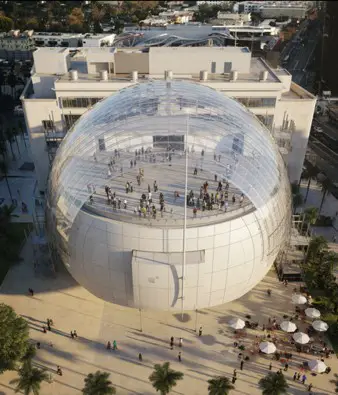
image courtesy of architects practice
Curatorial Team and Credits
Stories of Cinema is organized by Academy Museum of Motion Pictures Director and President Bill Kramer, Senior Director of Curatorial Affairs Doris Berger, Exhibitions Curator Jenny He, and Assistant Curators J. Raúl Guzmán, Dara Jaffe, Ana Santiago, and Sophia Serrano, with support from Research Assistants Esme Douglas and Manouchka Labouba, the Academy Museum Inclusion Advisory Committee, and the Academy Branch Task Forces. The exhibition is presented by PWC. Major funding is provided by Gerald Schwartz and Heather Reisman. Generous support provided by Metro Goldwyn Mayer, Ruderman Family Foundation, FotoKem, Barbara Roisman Cooper and Martin M. Cooper, Jocelyn R. Katz, John Ptak and Margaret Black, Lauren Shuler Donner, Randy E. Haberkamp, Kevin McCormick and A. Scott Berg, and John and Lacey Williams. Technology solutions are generously provided by Panasonic and Sony Electronics Inc. Stories of Cinema is powered by Dolby. Academy Museum digital engagement platform sponsored by Bloomberg Philanthropies.
Hayao Miyazaki is presented by the Academy Museum of Motion Pictures in collaboration with Studio Ghibli. It is organized by Academy Museum of Motion Pictures Exhibition Curator Jessica Niebel and Assistant Curator J. Raúl Guzmán. Technology solutions generously provided by Christie®, and major support comes from the Arthur and Gwen Hiller Memorial Fund. This exhibition also is supported, in part, by the Los Angeles County Board of Supervisors through the Los Angeles County Department of Arts and Culture. In-kind airfare provided by All Nippon Airways. Special thanks to the Japan Foundation for their partnership.
Academy Museum film programs are organized by Bernardo Rondeau, Associate Curator and Head of Film Programs, and Robert Reneau, Film Program Coordinator. Education and Public Programs are led by Amy Homma, Director of Education and Public Programs; Eduardo Sanchez, Manager of Public Programs; and Julia Velasquez, Manager of Youth Programs. Gary Dauphin is Associate Curator of Digital Presentations, and Shari Frilot is guest curator for new technology and expanded cinema.
The Path to Cinema: Highlights from the Richard Balzer Collection is organized by Academy Museum of Motion Pictures Exhibitions Curator Jessica Niebel and Assistant Curator Ana Santiago. The Richard Balzer Collection is a gift to the Academy Museum and the Margaret Herrick Library from Patricia Bellinger Balzer.
Backdrop: An Invisible Art is organized by Senior Director of Curatorial Affairs Doris Berger and Collections Curator Nathalie Morris with support from advisors Cecelia Fire Thunder, Karen L. Maness, John Pohl, Tom Walsh, and Robert M. Yellow Hair.
The Oscars® Experience is powered by Dolby.
Support for the Academy Museum
The Academy Museum launched its pre-opening campaign in 2012 and in November 2020 announced that it had exceeded the goal of $388 million.
Individuals, corporations, and foundations that have made leadership gifts include Cheryl and Haim Saban (Saban Building), David Geffen Foundation (David Geffen Theater), Rolex (Rolex Gallery), Dalian Wanda Group (the Wanda Gallery), Hobson/Lucas Family Foundation in honor of Sid Ganis, Dolby Laboratories/Family of Ray Dolby (Dolby Family Terrace), The Walt Disney Company (Walt Disney Company Piazza), Marilyn and Jeffrey Katzenberg (Marilyn and Jeffrey Katzenberg Gallery), Steven Spielberg (Spielberg Family Gallery), Patricia Bellinger Balzer, Shirley Temple Black and Family (Shirley Temple Education Studio), East West Bank (East West Bank Gallery), Gale Anne Hurd (Hurd Gallery), Bob Iger and Willow Bay (Bob Iger and Willow Bay Terrace), LAIKA (LAIKA Gallery), Metro Goldwyn Mayer Studios, NBCUniversal, Netflix (Netflix Terrace), Participant, Cecilia DeMille Presley (Cecil B. DeMille Founders Room), PwC (for Stories of Cinema), Richard Roth, Gerald Schwartz and Heather Reisman (Gerald Schwartz and Heather Reisman Terrace), The Simms/Mann Family Foundation (Ted Mann Theater), Jeff Skoll, Wendy Stark of The Fran and Ray Stark Foundation, Barbra Streisand (Barbra Streisand Bridge), Steve Tisch (Steve Tisch Terrace), Warner Bros. (Warner Bros. Gallery), Wasserman Foundation (Wasserman Bridge), and Wolfgang Puck Catering. The Academy Museum’s digital engagement platform is sponsored by Bloomberg Philanthropies.
Donors to the Pillar Campaign, co-chaired by museum trustees Laura Dern and Kimberly Steward, which names the support columns in the Saban Building, include the William Anderson Family; Tom Hanks and Rita Wilson; Bob Iger and Willow Bay; Barbra Streisand; the Ron Meyer Family; Kimberly Steward, in honor of Hattie McDaniel; NBCUniversal; the Diller-von Furstenberg Family Foundation; AMBI; Lionsgate; MGM; Panavision; Paramount Pictures Corporation; Sony Pictures Entertainment; 20th Century Fox; Viacom; Lauren and Jason Blum; Participant Media, from Jeff Skoll; Christopher Nolan and Emma Thomas, through the Morf Foundation; the Katie McGrath and J.J. Abrams Family Foundation; Cinépolis; Lexus; Gaumont; Sophia Loren (funded by Regina Scully); Alice Guy-Blaché (funded by Impact Partners); Julia and Ken Gouw, in honor of Miyoshi Umeki; and the Oneida Indian Nation, New York, in honor of Native American musician and advocate Buffy Sainte-Marie.
A post-opening campaign to raise new endowment, programming, operating, and capital funds is being planned.
Visiting the Academy Museum
Tickets to the Academy Museum are available only through advance online reservations via the Academy Museum’s website and mobile app. General admission tickets for the Museum’s exhibitions are $25 for adults, $19 for seniors (age 62+), and $15 for students. Admission for visitors ages 17 and younger and California residents with an EBT card is free. Advance timed entrance for the The Oscars® Experience is available to general admission visitors via a separate $15 ticket. A general admission ticket is required to access The Oscars® Experience.
The Academy Museum’s inaugural public programs and film screening series will also be available for registration via the app. Tickets for film screenings and public programs are sold separately and do not require general admission to the museum. Tickets will be available only through advance online reservations via the Academy Museum’s website. Film screening tickets are $10 for adults, $7 for seniors (age 62+), $5 for college students, $5 for children (age 17 and younger), and $8 for Museum Members. Public and education program tickets range from free with admission to $20 for adults.
Photos by Iwan Baan / ©️ Iwan Baan Studios, Courtesy Academy Museum Foundation
Academy Museum of Motion Pictures Los Angeles Building images / information received 220921
Location: Los Angeles, Southern California, USA
Los Angeles Buildings
Architecture Tours Los Angeles by e-architect
Contemporary Los Angeles Architecture
Architects: FreelandBuck
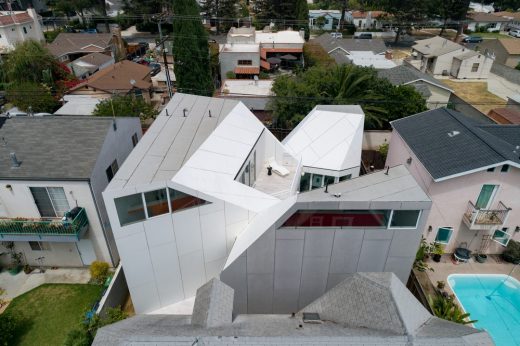
photograph : Eric Staudenmaier
Second House in Culver City
Design: Eric Owen Moss Architects
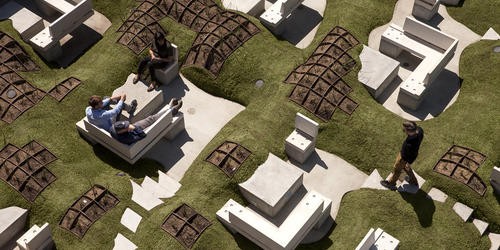
image courtesy of architects office
Vespertine Culver City Building, L.A.
New Architecture in Los Angeles
L.A. Architectural Projects
Design: MAD Architects
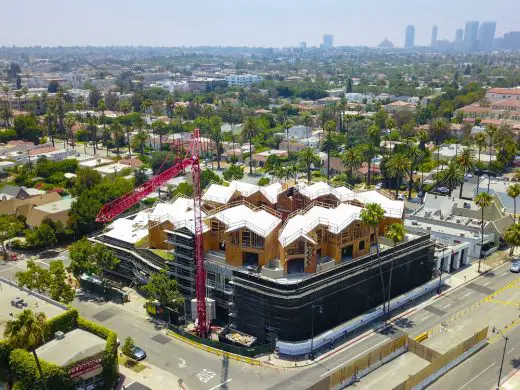
image Courtesy architecture office
Gardenhouse Wilshire Boulevard
Comments / photos for the Academy Museum of Motion Pictures Los Angeles Building page welcome

